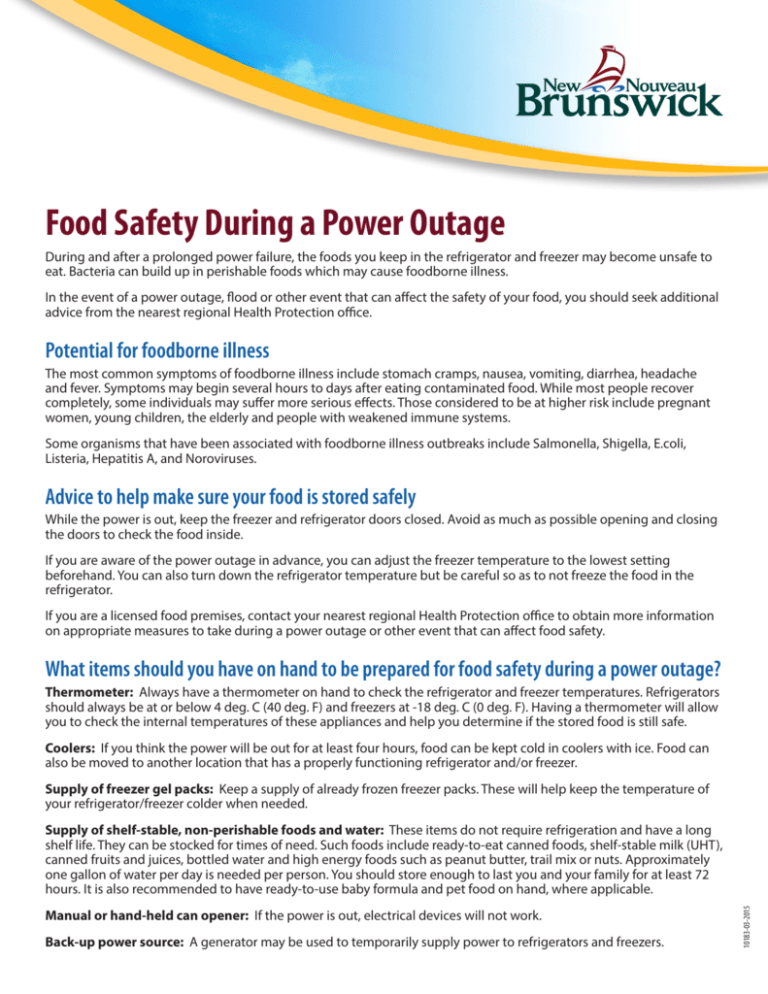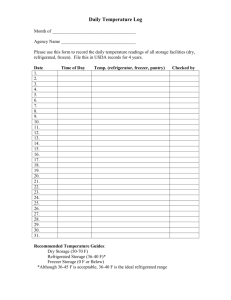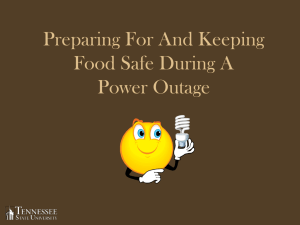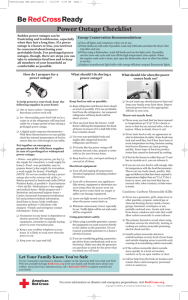Food Safety During a Power Outage
advertisement

Food Safety During a Power Outage During and after a prolonged power failure, the foods you keep in the refrigerator and freezer may become unsafe to eat. Bacteria can build up in perishable foods which may cause foodborne illness. In the event of a power outage, flood or other event that can affect the safety of your food, you should seek additional advice from the nearest regional Health Protection office. Potential for foodborne illness The most common symptoms of foodborne illness include stomach cramps, nausea, vomiting, diarrhea, headache and fever. Symptoms may begin several hours to days after eating contaminated food. While most people recover completely, some individuals may suffer more serious effects. Those considered to be at higher risk include pregnant women, young children, the elderly and people with weakened immune systems. Some organisms that have been associated with foodborne illness outbreaks include Salmonella, Shigella, E.coli, Listeria, Hepatitis A, and Noroviruses. Advice to help make sure your food is stored safely While the power is out, keep the freezer and refrigerator doors closed. Avoid as much as possible opening and closing the doors to check the food inside. If you are aware of the power outage in advance, you can adjust the freezer temperature to the lowest setting beforehand. You can also turn down the refrigerator temperature but be careful so as to not freeze the food in the refrigerator. If you are a licensed food premises, contact your nearest regional Health Protection office to obtain more information on appropriate measures to take during a power outage or other event that can affect food safety. What items should you have on hand to be prepared for food safety during a power outage? Thermometer: Always have a thermometer on hand to check the refrigerator and freezer temperatures. Refrigerators should always be at or below 4 deg. C (40 deg. F) and freezers at -18 deg. C (0 deg. F). Having a thermometer will allow you to check the internal temperatures of these appliances and help you determine if the stored food is still safe. Coolers: If you think the power will be out for at least four hours, food can be kept cold in coolers with ice. Food can also be moved to another location that has a properly functioning refrigerator and/or freezer. Supply of freezer gel packs: Keep a supply of already frozen freezer packs. These will help keep the temperature of your refrigerator/freezer colder when needed. Manual or hand-held can opener: If the power is out, electrical devices will not work. Back-up power source: A generator may be used to temporarily supply power to refrigerators and freezers. 10183-03-2015 Supply of shelf-stable, non-perishable foods and water: These items do not require refrigeration and have a long shelf life. They can be stocked for times of need. Such foods include ready-to-eat canned foods, shelf-stable milk (UHT), canned fruits and juices, bottled water and high energy foods such as peanut butter, trail mix or nuts. Approximately one gallon of water per day is needed per person. You should store enough to last you and your family for at least 72 hours. It is also recommended to have ready-to-use baby formula and pet food on hand, where applicable. Your freezer • • • • • • A full freezer will keep food frozen for about 48 hours. Similarly, a half-full freezer will keep food frozen for about 24 hours. Blocks of ice can be used to help keep the temperature to a safe level. Ensure ice is from a safe source. If you know the power will be out for longer than 48 hours, you may move perishable food to another location that has a properly functioning refrigerator and/or freezer. Partial thawing and refreezing may reduce the quality of some food, but it will remain safe to eat. Do not put frozen (or any) food outside, even during winter, unless protected in a cooler with ice. If it’s a sunny day, find a shaded spot if necessary. Food that still contains ice crystals or feels ‘refrigerator cold’ (i.e., 4 deg. C or 40 deg. F) may be re-frozen. Otherwise, do not refreeze food. Your refrigerator • • • • An unopened refrigerator will keep food cool for about four hours. Blocks of ice can be used to help keep the temperature to a safe level. Again, ensure ice is from a safe source. Throw out any food with a strange color or odor as soon as possible. Make sure raw meat, poultry or fish are well wrapped and placed in the coldest section of your refrigerator and on the very bottom. Breastmilk • • • • Throw out refrigerated breastmilk when the power has been out for 24 hours. Throw out frozen breastmilk from a fully packed freezer when the power has been out for 48 hours. As an added precaution, discard after 24 hours if feeding a preemie or an infant with immune issues. Breastmilk that has been frozen and still contains ice crystals can be refrigerated and used within 24 hours of refrigeration. Freshly expressed breastmilk is safe for 4 to 6 hours at room temperature. When to throw food out • • • Throw out any thawed or perishable food that has been above 4 deg. C (40 deg. F) for two or more hours. Some examples are: »» raw or cooked meat, poultry, seafood and luncheon meats »» eggs »» casseroles, stews or soups »» milk and soft cheeses »» homemade mayonnaise or dressings »» cooked pasta, potatoes or rice »» salads made with any of these foods »» Leftovers made with any of these foods Discard any food items with an obviously strange color or odor. Remember that contaminated food may not look or smell bad. Carefully inspect all food items and do not eat any food you think may not be safe. When in doubt, throw it out. Discard foods that have damaged packaging, such as crushing, denting, deep rusting, holes, leakage, punctures and swelling. Areas inside refrigerators, freezers, and containers used for temporary food storage that contain any spillage or leakage from raw food during thawing must be cleaned and sanitized. Homeowners may sanitize by using a mixture of 1 teaspoon of regular unscented household bleach and 1 liter of water. Licensed food premises must have a means of testing chemical sanitizer strength so the above solution may not be used. Do not reuse these cloths until cleaned and disinfected. Your medication • If you need information on proper storage of your prescription drugs that require refrigeration, such as insulin, call your doctor or local pharmacist. More information Canadian Food Inspection Agency fact sheet ‘Food Safety in an Emergency’: http://www.inspection.gc.ca/food/ information-for-consumers/fact-sheets/food-handling/emergency/eng/1331578972167/1331579901110 Public Safety - Emergency Measures Organization: http://www2.gnb.ca/content/gnb/en/departments/public_safety/ emo.html Specific foodborne diseases: http://www2.gnb.ca/content/gnb/en/departments/ocmoh/cdc/content/food_ andwaterborne.html. General food safety information: http://www2.gnb.ca/content/gnb/en/departments/ocmoh/healthy_environments. html Regional Health Protection Offices: http://www2.gnb.ca/content/gnb/en/departments/ocmoh/healthy_ environments/content/regional_branch_offices.html





